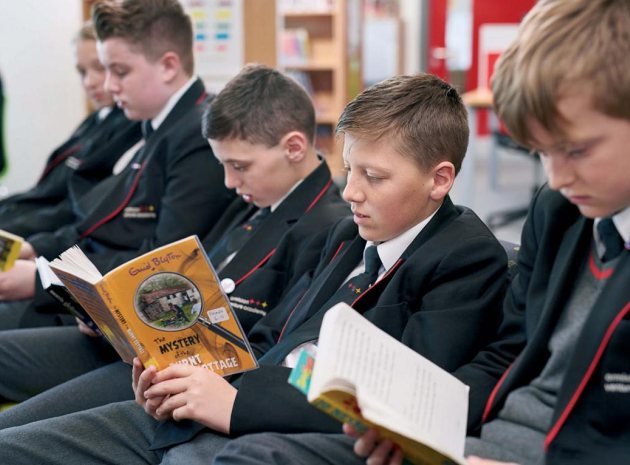English teacher Luke Richardson, of Nottingham, is trialling PAWS For Reading with his KS3 students to develop not only their reading, but their thinking about reading. It’s a scheme that uses a drawing of a paw as a prompt for feedback, with the headings Predict, Again and Wonder printed in the three digits, and Summary on the pad.
“The idea is they fill in Predict before they start reading,” explains Luke. “If it’s a book, they should be able to have a good guess about what’s coming up in the next chapter. If it’s a text you’ve chosen, show the title, the first line or a picture linked to it, and see what they come up with. Read the text, then read through it Again – if it’s a whole chapter, ask students to note things down as they’re reading. Then discuss – is there is anything they’re not sure about? Is there anything they need to clarify, or words of phrases they don’t understand? What do they Wonder about the text? Are there any questions they have about what is going to happen? Why did this take place? Summary is the tricky part – if students can do it effectively, they’re doing well. Can they summarise the text they’ve just read? Have they missed any parts?”
At Forest Hall School, in Essex, there’s a whole package of programmes in operation aimed at inspiring students to get interested in literature. Initiatives include Drop Everything And Read sessions in form time; fun ‘shelfie’ photo challenges of students with their books; a ‘guess the teacher’s favourite childhood book’ competition with clues posted around school; and a murder mystery where students have to read clues, police and lab reports to work out who committed the crime. Throughout December last year, an advent calendar campaign promoted a book video trailer every day to encourage students to pick up and try a new title, while on World Book Day students read an entire book in a day, with the first ten minutes of each lesson dedicated to reading it together. And that’s just some of the ideas being used.
“I even read to my form class,” says librarian Sarah Wedgbrow. “Some students may never have experienced being read to by an adult before. It’s important for them to hear the words so they can access the narrative and imagine it – the story element to reading is really important. We are constantly trying different things, but always making sure they are relevant to our learners’ lives.”
Personal choices
Teachers are coming up with their own tactics, then, to inspire students to pick up a book and read. But as far as Kamilah Hale, founder of the tuition company Kin Learning, is concerned, it doesn’t have to be a book, particularly, so long as young people are choosing to read at all. “We find our older students often have two issues with reading,” she points out. “One is difficulty with sounding out new words, and the other is struggling to comprehend the passage. I encourage students to read satirical articles on The Onion and to browse fashion, interviews and even celebrity gossip in magazines like Vogue and Vanity Fair. As my students already have some real world context around these articles, they feel more accessible in terms of comprehension; and the brevity helps, too, of course. I find they also include challenging enough vocabulary for my students to have to sound out and learn new words, as well as a variety of metaphors and similes, often for comic effect.”
Everything changes
Sue Wilkinson, of The Reading Agency, a charity which inspires people of all ages to read for pleasure and empowerment, agrees. “We believe everything changes when you read,” she says. “There is strong evidence that reading for pleasure can increase empathy, improve relationships with others and have a positive impact on wellbeing. But, our research shows people of all ages are more likely to see these benefits if they choose to read and enjoy doing so. So, we need to encourage young people to read the things they enjoy, in a way that suits them.”
Listen and learn
“Establishing a reading for pleasure environment is as much about developing confidence as it is about academic achievement,” confirms Kate Edwards, from the charity Seven Stories. “If a student has had a negative reading experience in the past, it is important to encourage them to read what genuinely interests them – a comic, a menu, a build-it manual – the point is it is a stepping stone to further reading. Linking books to interests is helpful, too – so get to know your students and make recommendations.”
For SEN students, the challenge can be even greater. “I am a huge proponent of listening to audiobooks,” insists Kamilah Hale. “For SEN students, we need to decide which skills we’re trying to build when encouraging them to read for pleasure – it can be overwhelming if we try to improve everything at once. Generally speaking, we want children to develop comprehension, learn how to use descriptive language, learn vocabulary, practise reading new words and improve spelling and grammar. Many of these aims can be achieved through listening to audiobooks. Switching between ‘reading with your eyes’ and ‘reading with your ears’ helps SEN students to enjoy a story more, so they can become less nervous when working on English in general.”
Finally, don’t rule out physical obstacles that could be making reading a struggle for some of your learners. “About 60% to 80% of poor or reluctant readers have some kind of visual difficulty,” warns optician and behavioural optometrist Bhavin Shah, of Central Vision Opticians in London. “These children often slip through the net because underlying problems are not always detected at a routine sight test.” If you suspect this might be the case for one or more of your learners, it’s worth speaking with the parents or carers about consulting a behavioural optometrist who will have additional expertise in treating these specific issues, before they hinder the student’s education.
Four quick ideas for your school:
• Ask students what problem they want to solve (e.g. how to be respected, or how to find a boy/girlfriend), and hand them two books in which people tackle the issue in two different ways.
• Create lunchtime book clubs for those who are shy or have friendship issues. Reading can give troubled teens a world into which they can escape. As writer Kirsten Rees, of Make Me A Success, observes, “I can wholeheartedly say from experience I would have gone to one – I was bullied and felt alone at times. Reading eventually led to me becoming a writer!”
• The Reading Agency’s Reading Hack inspires students to read for pleasure by linking it with genuinely engaging youth-led projects, such as volunteering, event planning and creative activities.
• Teachers can become positive ‘reading for pleasure’ role models within the classroom by displaying signs which show what they are reading, and by being seen to enjoy books themselves.








